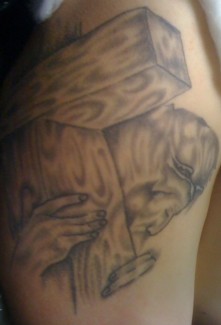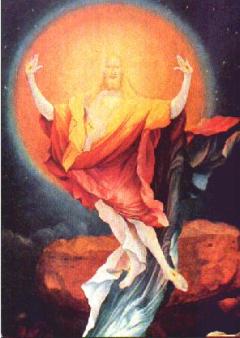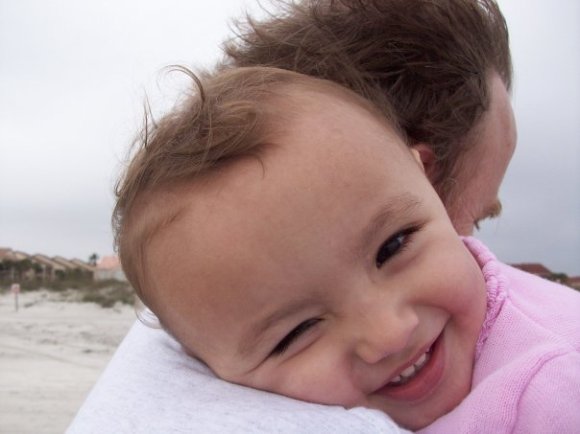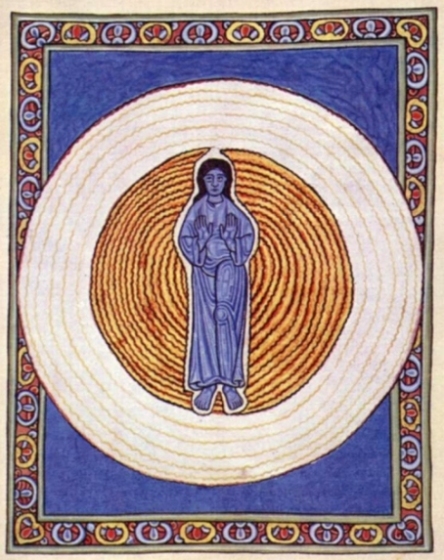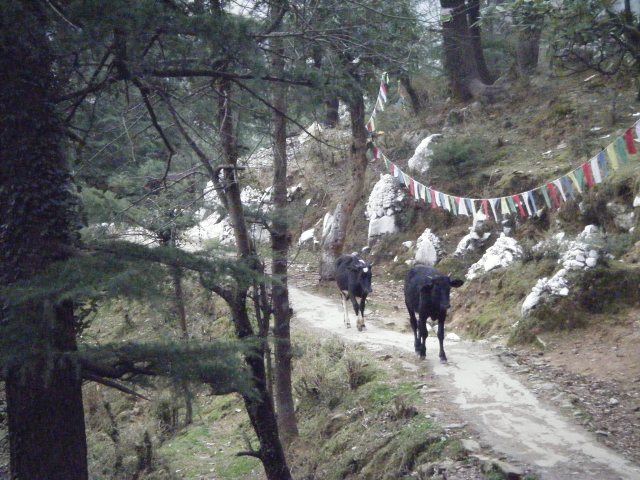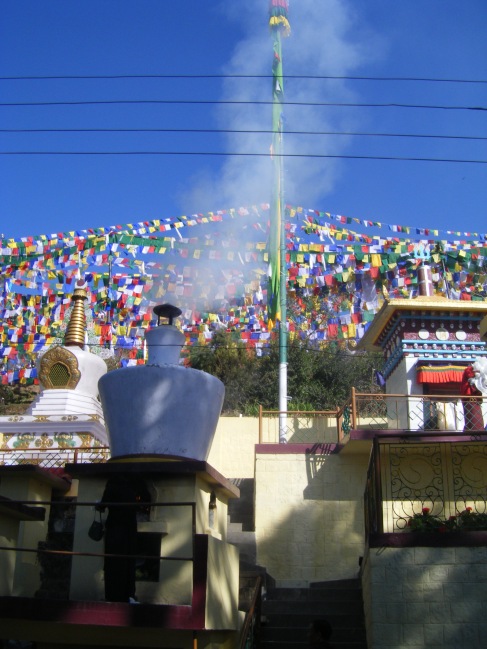Title: Path to God through self-knowledge–a talk given on retreat at Gethsemani Abbey
We already know one path to God, it is just around the corner—you go out the door and there is the Gate—just go through God Alone—that is the path to God, unfortunately, it is a restricted monastic area and we can’t go on that path.
However, I can do one better. You don’t have to even leave this room, to get on the path, St Teresa of Avila says, “the soul is advised to enter within itself.”
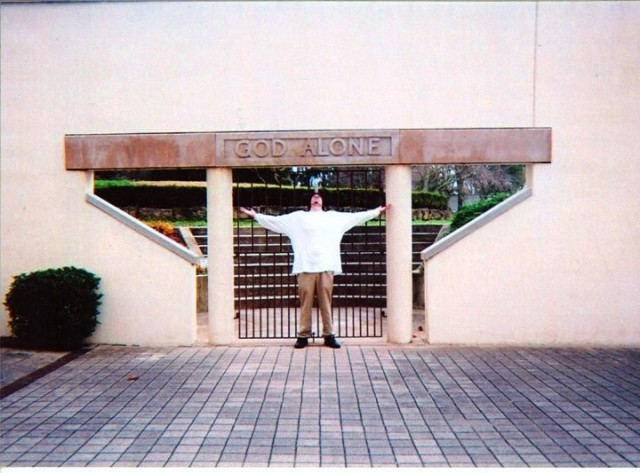
My topic today is self-knowledge as a path to God, I’ll begin with some lines from Psalm 19 on the theme of self-deception that grows out of presumption
| 12 | Who can tell how often he offends? * cleanse me from my secret faults. |
| 13 | Above all, keep your servant from presumptuous sins; let them not get dominion over me; * then shall I be whole and sound, and innocent of a great offense. |
| 14 | Let the words of my mouth and the meditation of my heart be acceptable in your sight, * O LORD, my strength and my redeemer. |
What is self-knowledge?
Who am I and who is God? These two questions are fundamental to our being. Coming to the monastery, the novices are asked by the Abbott, “What do you seek?” As directed by the liturgy, they answer “The mercy of God, and the fellowship of this community.” To further the overall purpose of seeking God, I will draw upon the advice of St. Teresa of Avila, that self-knowledge is essential in the quest to know God. She writes:
I do not know if I have explained this clearly: self-knowledge is so important that, even if you were raised right up to the heavens, I should like you never to relax your cultivation of it; so long as we are on this earth, nothing matters more than humility. And so, I repeat that it is a very good thing — excellent, indeed — to begin by entering the room where humility is acquired rather than by flying off to the other rooms. (Teresa of Avila: First Mansions, Chapter 1)
To answer the question what self-knowledge is? we need to know what a self is and what knowledge is. As a trained philosopher, who has reflected on this question over several decades I have to be careful here and keep a rein on an analytic mania which could easily send me off galloping through several answers. These philosophical issues are important and that inquiry into those very large questions can be fruitful. However, I take it that this is a retreat setting and what we need is a working definition that we can use to help us grow in self-knowledge and draw closer to God.
On the one hand self-knowledge seems to be self-evident and just on the surface of things. I know my roles as husband, father, son; I know my immediate feelings (more or less)—this kind of knowledge is given in our everydayness. The depths of the feelings or the depth of our inhabiting roles may sometimes seem especially urgent and powerful. The loss of a mother, or a child may open a new depth to our everyday knowledge. So, one thing I want to say about self-knowledge is that as contemplatives we seek a certain depth of knowledge. Psalm 130 cries “out of the depths I have cried to you.” The Latin name of this Psalm “de profundis” also indicates, that we seek a deeper self-knowledge, a “something” hidden underneath what we already know.
In The Inner Experience Thomas Merton takes a stab a definition of the inner life. He writes, he inner self is, “first of all, a spontaneity, that is nothing if not free.” Spontaneity R us. Our true self is not a “thing” in us that we can find, it is a freedom to respond. A free receptivity is what we “really are.” It is out of this freedom, that we can find God. Merton also speaks of this inner life as a direct intuition. Intuition is a slippery sort of word but for Merton it is an experiential reality that is grasped by faith. This experience of God is what calls novices to the monastery and keeps those in the monastery satisfied to remain. However, this intuition does not come easily nor without many pitfalls and dangers. The Cistercian charism with its emphasis on humility also claims that there are dangers of self-deception common to us all—stemming from pride in our own knowledge as if we are the lords of knowledge and truth.
We must also caution ourselves to view self-knowledge as an unfolding process. There are facts about us that we do well to attend to, but our self-knowledge is something that reveals itself as we create ourselves day by day through our choices and loves—the depths (or perhaps the shallowness) of our hearts are revealed in these choices.
Teresa encourages her Carmelite sisters to think of our true self (or our soul) as a great castle. It has many rooms and dwellings, because our soul as created by God is meant as a dwelling place for God. She writes, “Sisters, we realize that the soul of the just person is nothing else but a paradise where the Lord finds his delight. So, then, what do you think that abode will be like where a King so powerful, so wise, so pure, so full of all things takes delight?”[1]
I’d like to pause for a moment here and ask you to join me on a guided meditation, loosely based on St. Teresa’s interior castle. So, if you don’t mind, please sit up straight, get comfortable and close your eyes and take a few deep breaths.
Guided meditation
- I want you to “enter into yourself” and imagine yourself in a vast and expansive room, with three chambers. Look up to the top of the room and note how it extends upward, perhaps almost out of sight. You are in a great treasury. What do you see there in that expanse? Give yourself some time to take in its scope. It is the scope of your soul. It is large because in addition to housing you and all your possibilities, it also houses God.
- As you look at the chambers you see three headings for the three chambers, Memory, Understanding and Will.
- You look to the memory, there are your memories lighting up like glass globes, you see your mother’s memory, it lights, your family, your state, your nation and the memory of all peoples. All possible memories have a glass globe, marvel at the size knowing that all possible memories could come to you.
- You look at the chamber called will and are given to understand that all your desires, loves and joys belong there, they light up green and blue and various colors. There is also room for the joys and loves of those you love they also fill the room—all possible loves and joys of all the world reside there. This room can house the joy of all nations. You are given to understand that when God comes into the will, all these globes will light up. Consider all the vastness of this, it is as vast as the Kingdom of God, it too has room for all the kingdom in it, your will, God’s will the will of all people can reside there.
- Then in the middle of the three rooms, you notice a mirror. A nun is standing beside it. It is St Teresa of Avila. She beckons you toward it and you come beside her and to stand before the mirror. As you stand before the mirror, you look and see yourself; as you look Teresa tells you, “In this mirror, all the good that you see in your being and in your deeds come because they have their origin in God. You cannot look upon this mirror without giving praise to God and rejoicing in God’s power. If you turn away from the divine source all will go dark and how deep the darkness will be! But if you turn to God and in humility give God glory, you will shine with a beautiful light.”
- Stand there before the mirror, look, take three deep breaths and then slowly bring yourself back to the conference room.
Let me talk further about Teresa’s castle. This Teresian image of a large castle with many dwellings, has a deepest center to it, the seventh dwelling, called the bridal chamber where God chooses to meet the soul in its deepest center. The spiritual life, as depicted by Teresa progresses by moving toward the center where the vision of God is seen intimately. However, it is not just in this inner room that we live or are deeply connected to God. The quote mentioned earlier shows Teresa urging those in her care not to go flying off to the inner rooms without first having a firm grounding in the first dwelling the room of humility and self-knowledge.
She stretches the castle metaphor by two compounding images—the image of a diamond and the image of a palmetto frond. As a Florida boy, I especially like this one. In in a palmetto the outer separate leaves are all bound to the center in a series of folds that come together in the center of frond. Similarly, the room of self-knowledge is also connected directly to the most interior chamber, like the outer edge of a palmetto is conjoined to a radiating center. The castle is also made of a diamond or clear crystal—the light of God’s presence in the interior can immediately and directly radiate into the room of self-knowledge; even the outer rooms can be illumined from God’s presence in the inner recesses of the soul. God can be seen just as clearly owing to the crystal structure. So that the true self is known as it is known by God—and we see ourselves as God sees us—face to face.
All this is rather abstract so far and so let me turn and talk about something practical and some of my own experience in self-knowledge and so I turn to something that happened in my past. It would be odd if I were to give a talk on self-knowledge as a path to God without talking about my self-knowledge. I can talk about myself a lot; my hope is that it won’t be painful to you. In Baptist-speak, I am going to give you my testimony. That’s proof that you can take the boy out of the Baptists, but you can’t take the Baptist out of the boy.
About 9 years ago, my youngest son, Casey Olmsted, was murdered. It was a shocking grief for me and our family. I was informed of this on my way driving to work. After I hung up, I just shouted in my car, “I can’t do anything, I can’t do anything.” My wife and I had “fixed” a lot of things for our son, but this was an irreparable harm. I had come to take part in LCG just slightly before this and I found significant help in the community that I had joined. Aside from dealing with the grief, I also had to deal with an intense hatred and anger, that grew up in me toward, Leland Burns, the 60-year-old man who had shot my son. I had violent fantasies I would lose myself in; from time to time I would look down and my fists would be balled up ready for a fight, or worse yet, positioning myself holding a gun. To put things into St. Teresa’s terms, things were not looking pretty in the room of self-knowledge, it was darkened with thoughts that did not have their origin in God. I was nurturing murderous thoughts that were not so great for my own happiness, but worse, I was harboring a mortal sin that would block the possibility of coming joyfully into the presence of God. The crystal nature of the soul can turn to black by turning away from God.
I came to know some very painful things in the room of self-knowledge, how fragile I and my loved ones are, how little control I have over my thoughts. Some had urged me to forgive right away. I was not ready for that, the advice that made the most sense was from Fr. James Conner who told me to pray that one day I would be able to forgive; that was something manageable. In that time, day by day I worked on the slow unclenching of my fists, when I recognized that they were clenched, a turning away from the fantasies that recurred. Thousands of re-directions later and over time some release of the anger and feelings of hate—but then something different happened. It had been about two years since his death, we were winding up a second civil trial after the murder trial and we had it arranged through his lawyer to meet with Mr. Burns and to receive his apology at the close of the trial. It was a few days before the trial, I was out in our sun-room one morning, keeping quiet, saying the Jesus prayer. I wasn’t sure if my forgiving Burns would be a betrayal of Casey and I had been asking God to show me what Casey’s mind was like and how forgiveness worked in heaven. All of a sudden, something came over me, a peace, a sense of being loved and of loving. If I had to tell you what it was exactly I experienced, I would tell you “blue.” There was an image of blue in my mind that enveloped me, amazing my mind, warming my heart and buoying me up in a joy. I believe this is what people call “the peace that passes all understanding.” I sat there, I don’t know how long, I think it was no more than 20 minutes. Believing that I had discovered this place in my mind, that I could go back to, I got up, I had a meeting I had to get to. Later, as I sat, I found that this was not something I could conjure. Fr. James advised me to look on it as a one-time event of grace that I was blessed to receive. I believe, perhaps, I even dare to say, “I know” this was from God. The safest way to put it, is as Merton does “a supernatural intensification of faith, it is an experiential grasp of God as present within our inner-self. ”[2] God was moving in me, to love and to forgive.
If I understand this experience rightly, (a big if), God had showed me that within myself, and with the grace of God’s presence, I had that possibility to love and forgive that were far beyond what happened when I was putzing around by myself in the room of self-knowledge and humility. Through God’s power my soul had the power to transcend itself and to be divinized by grace. Gone were the impotent redirections of my own power that worked for a few moments and then I reverted back to hatred and pain. On my own, it was like I was trying to tear down a barn, pulling nail by nail and hauling it off board by board and then a flood came along leveled the barn and carried it down the river. Now I was moving swiftly and definitively to forgive with a magnanimity I could scarcely imagine. To tie this back to Teresa of Avila, I had experienced a great consolation from God. Teresa though is careful to say that such consolations are not to be expected on a regular and continuing basis. Certainly, she herself, had many consolations but they were intermittent.
Teresa distinguishes between two types of consolation by comparing them to water. One type of consolation is ordinary and is compared to the water delivered by aqueducts—it is a steady flow of grace by “natural” channels. On the other hand, there is the kind of water that is like a spring, a boundless surging up of water by its own power that delivers itself unbidden. When Jesus talks to the woman at the well, and says, “you will have water welling up in you, bubbling up into eternal life” I think that he is referring to a kind of experiential divine power that our souls are created to receive. My testimony to you, is that there is a great well-spring possible within us. I know that I will not be able to fully explain this to you. It can easily seem like passing feeling. But I tell you it carried in it a great power from beyond. As a Florida boy, looking into the great springs and the rivers that issued out of them, the notion of a crystal fountain that comes from the mouth of the earth to give life-giving water is a powerful one.
On the strength of this experience, I was able to sit down with Mr. Burns at the close of his trial and to accept the forgiveness he tried to tender to my wife and me. I could, in a very limited fashion, wish him well. My wife and I listened to him and in sympathy for him accepted that his life had been broken by this too. Perhaps, someone in the back of the room, is thinking, that’s all well and good, but Casey is just an excitable fellow, prone to all kinds of fancies. I get that, I have those same feelings of self-doubt. I have had some strange things happen, sometimes the hair on the back of neck will stand up and I will feel moved in a certain direction—but perhaps it is not God; perhaps it is static electricity or something. The scriptures tell us to test every spirit; St. Teresa urges that you have a reliable spiritual director as a sounding board.
When we test these experiences, what do we look for? Teresa’s answer is a simple three words: Deeds, deeds, deeds. Do these experiences produce deeds of loving kindness? This is the point of God’s revelations in us, to reform us, to make us grow in love, and to convert our manners. The experiences, as powerful as they are, are not ends in themselves so that we collect religious experiences like baseball trading cards—it is that we grow in the love of God and the love our neighbor. One thing I will say about my experience that leads me to believe is that it has a kind of continuing passive effect that works itself in me without effort or consciousness on my part. Teresa’s compadre, St. John of the Cross, is very eloquent about this working of God in us when we are cooperative but also passively in us when we are not particularly thinking about God. For example, even now when I see the sky a certain color blue, I am taken back to the moment and buoyed in my joy and peace. It is not something that I can conjure, it is rather something that conjures me. A coffee mug that my oldest son made for me is a particular color of blue that I can look at and grow stronger in just seeing.
One of the ongoing effects of this experience happened very recently when I was walking into Wal-Mart and came to see by total accident Leland Burns the man who had killed my son, Casey. I wrote a poem about the event, but the poem is unbelievably bad. So bad that I cannot share it with you—but I have found just the right poem that can capture something of what I was trying to say. However, to set the stage for the poem I need to tell two stories; pay attention Br. Frederick, they are Irish stories and they may help to answer a question about the spiritual state of Ireland that you were asking me about. I know this is what we might call an abrupt shift—just bear with me through these two stories and the poem and I’ll wrap things up.
The first story is about an Irishman named Gordon Wilson. Gordon Wilson was a working man, a draper. He worked with his daughter in a business and one day, his daughter was killed, and he was badly injured in a payback bombing that later came to be known as the Innisfree atrocity. A few days after the bombing, Gordon Wilson appeared on national tv, arm still in a sling, plaster cast on and said that he forgave the killers of his daughter and called out for peace. That’s the first story.
Here’s the second, a notable Irish poet, Michael Longley was inspired by Gordon Wilson’s magnanimity in this and he wanted to use part of this inspiration to contribute as a poet to what might be called a “peace process.” Longley was put in mind of the greatest war poem ever, the Iliad. At the close of the story Achilles has finally killed Hector in vengeance for Hector’s killing of his beloved Patroclus. In his fury, Achilles wishes to do more than kill, he wishes to mutilate Hector’s corpse and ties it to his chariot and drags it round and round outside the city gate. At the end of the day, his fury still raging, the father of Hector, King Priam, goes to Achilles at night to beg for the body of his dead son. It is this scene from the Iliad that the poet Michael Longley puts into a sonnet.
Michael Longley, “Ceasefire”
I
Put in mind of his own father and moved to tears
Achilles took him by the hand and pushed the old king
Gently away, but Priam curled up at his feet and
Wept with him until their sadness filled the building.
II
Taking Hector’s corpse into his own hands Achilles
Made sure it was washed and, for the old king’s sake,
Laid out in uniform, ready for Priam to carry
Wrapped like a present home to Troy at daybreak.
III
When they had eaten together, it pleased them both
To stare at each other’s beauty as lovers might,
Achilles built like a god, Priam good-looking still
And full of conversation, who earlier had sighed:
IV
‘I get down on my knees and do what must be done
And kiss Achilles’ hand, the killer of my son.’
It’s a beautiful poem. Longley says that when he was writing it, and the part about Priam he had in mind Gordon Wilson’s face as the image of King Priam.
And so, with that poem in mind, I recall seeing. It seems to call up what I want to say happened when I ran into my son’s killer, Leland Burns. I was traveling to Bowling Green and stopped at the center of the world where all roads cross, you know, Wal-Mart, to get something. Upon entering the store, I saw him. I did a double take, like I couldn’t believe it was him. I was not recognized but I stared at him. He was not the man with the hollowed-out eyes, thin from jail food. Here he was a fisherman’s tan, dark and beautiful, a tee shirt with the sleeves cut out and emblazoned with the logo of Lynard Skynard, cradling a mountain dew and leaning over and joking with his buddy with him. I had been wondering if he had recovered but here was the answer staring me in the face. Yes! I was tempted to say, “hi.” Or to call out his name—I wanted to but, where would any conversation go after that? I remained content just to watch, it was enough to see him restored. I was able to be hospitable in my gaze, and I gave thanks to God, I could do that, almost effortlessly because of what God had worked in me. I was, free of the presumptuous sin of judging him as if I were God and my hatred was God’s hatred. I could be whole and sound, free of a great offense. I could be free to love this one who had once been a hated enemy.
And so, I close with the scripture that I began with.
| Who can tell how often he offends? * cleanse me from my secret faults. |
| Above all, keep your servant from presumptuous sins; let them not get dominion over me; * then shall I be whole and sound, and innocent of a great offense. |
| Let the words of my mouth and the meditation of my
heart be acceptable in your sight, * |
Amen
Handout
Self-knowledge: Humility
“I have said a great deal elsewhere, daughters, about the harm which comes to us through our not properly understanding this matter of humility and self-knowledge . . . it is a matter of the greatest importance to us.” (Teresa of Avila: First Mansions, Chapter Two)
I do not know if I have explained this clearly: self-knowledge is so important that, even if you were raised right up to the heavens, I should like you never to relax your cultivation of it; so long as we are on this earth, nothing matters more than humility. And so I repeat that it is a very good thing — excellent, indeed — to begin by entering the room where humility is acquired rather than by flying off to the other rooms. (Teresa of Avila: First Mansions, Chapter 1)
Self-knowledge and Knowing God
As I see it, we shall never succeed in knowing ourselves unless we seek to know God: let us think of His greatness and then come back to our own baseness; by looking at His purity we shall see our foulness; by meditating upon His humility, we shall see how far we are from being humble. (Teresa of Avila: First Mansions, Book Two)
Sisters, we realize that the soul of the just person is nothing else but a paradise where the Lord finds his delight. So, then, what do you think that abode will be like where a King so powerful, so wise, so pure, so full of all things takes delight? I don’t find anything comparable to the magnificent beauty of a soul and its marvelous capacity. Indeed, our intellects, however keen can hardly comprehend it, just as they cannot comprehend God; but He Himself says that he created us in His own image and likeness. Teresa of Avila: First Mansions, chapter 1.1, p.35)
A few more comments from Teresa deserve mentioning. According to St. Teresa, we enter into ourselves through the door of prayer and reflection. She says that prayer and reflection are not just verbal utterances; in speaking we must know who we are and who we are addressing. It is shameful to have no memory of who we are like some amnesiac. Teresa writes,
‘a prayer in which a person is not aware of whom she is speaking to, what she is asking, who it is asking and of whom, I do not call prayer, however much the lips may move.” Interior Castle, First Dwelling, 1. 7, p.38
Thursday, December 14, 2006
Michael Longley, “Ceasefire”
I
Put in mind of his own father and moved to tears
Achilles took him by the hand and pushed the old king
Gently away, but Priam curled up at his feet and
Wept with him until their sadness filled the building.
II
Taking Hector’s corpse into his own hands Achilles
Made sure it was washed and, for the old king’s sake,
Laid out in uniform, ready for Priam to carry
Wrapped like a present home to Troy at daybreak.
III
When they had eaten together, it pleased them both
To stare at each other’s beauty as lovers might,
Achilles built like a god, Priam good-looking still
And full of conversation, who earlier had sighed:
IV
‘I get down on my knees and do what must be done
And kiss Achilles’ hand, the killer of my son.’
At the Crossroads, Ken Casey
There, at the center of the world, where all roads meet
The Wal-Mart entry way, silver locks down
dangling over his shoulders. Farmer tanned, black tee shirt,
cut off sleeves emblazoned with Lynard Skynard
The man who murdered my son,
Smiling, joking with his buddy
Cradling a liter of mountain dew next to some motor oil.
An old question rears up, can we recover?
Nine years ago, eyes sunken, hair tied back
Ghostly pale and thinned from prison food
Like one ridden hard and put up wet
You had tendered a gesture in a broken apology
How far from then we are now!
The shame washed off, you move free
Like a broken hand healed
Fingers, now deft, nimble, dancing across the frets–rippling grace notes through music
[1] First Dwelling, chapter 1, 1. P. 35
[2] Merton, Inner Experience, p. 12

